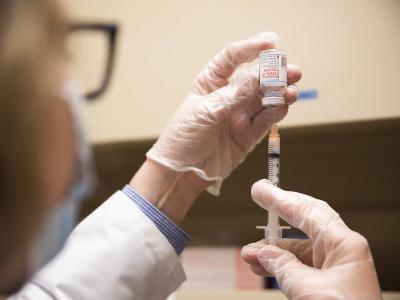Study finds prolonged courses of antibiotics common at discharge
A multicenter study looking at total durations of antibiotic exposure related to hospitalization indicates that more than a third of hospital-related antibiotic exposure occurs after patients are discharged from the hospital, researchers from Duke and the Centers for Disease Control and Prevention (CDC) reported yesterday in Infection Control and Hospital Epidemiology.
For the retrospective study, researchers collected and reviewed electronic data on inpatient and discharge antibiotic prescribing from three pilot hospitals in the southeastern United States from April to September 2016. The primary metric of total duration was defined as the inpatient length of therapy (LOT) plus postdischarge LOT. Postdischarge prescription durations were calculated from electronic discharge prescriptions (e-scripts).
A total of 45,693 admitted patients were evaluated over the 6-month study period. Of these admissions, 23,447 (51%) received inpatient antibiotics and 7,442 (16%) received e-scripts at discharge. E-scripts were prescribed for 348 (5%) admitted patients who did not receive antibiotics as an inpatient. The postdischarge LOT among admissions with discharge antimicrobials was median 8 days, with peaks at 5, 7, 10, and 14 days, and postdischarge days accounted for 38% of antimicrobial exposure days related to hospitalization. And because the estimates of postdischarge antibiotic days were subject to missing data based on avoidance of the electronic system in certain scenarios, the researchers say they could be underestimates.
The authors of the study suggest errors in the ordering process, electronic system defaults for outpatient prescriptions, and diagnostic uncertainty are among the reasons for excessive antibiotic durations on discharge.
"Our findings suggest that prolonged courses of antibiotic therapy are common at discharge and may contribute to unnecessary antimicrobial exposure in patients," they conclude. "ASPs [antibiotic stewardship programs] that target discharge prescription duration and appropriateness have an opportunity to reduce unnecessary antimicrobial use and its resultant harms. These activities should be incorporated to hospital quality improvement initiatives focused at improving safety at transitions of care."
May 28 Infect Control Hosp Epidemiol study
Carbapenemase-producing Enterobacteriaceae cases rise in Hong Kong
The number of patients in Hong Kong hospitals diagnosed with carbapenemase-producing Enterobacteriaceae (CPE) more than doubled from 2017 to 2018, according to a story yesterday in the South China Morning Post.
Dr. Raymond Lai Wai-man, chief infection control officer for Hong Kong's Hospital Authority, told the paper that the number of inpatients diagnosed with CPE, which is resistant to most antibiotics and can cause severe infections, rose from 473 in 2017 to 972 in 2018. To address the increase in cases and a rise in other multidrug-resistant organisms, Lai said the Authority is introducing a 5-point plan that includes more active screening for patients who've been hospitalized outside Hong Kong in the last 12 months, patients who've spent 14 days or more in the hospital, and patients who have unexplained diarrhea.
Lai said Hong Kong hospitals are also using rapid diagnostic tests to detect the superbug more quickly.
"This allows for quicker medical responses, such as single room isolation in hospitals, with the room wiped clean of bacteria, and nurses dressed in protective gowns and gloves when entering and leaving it," he said.
The Hospital Authority has also implemented an antibiotic stewardship program to monitor antibiotic prescribing at Hong Kong hospitals.
In another story from the same paper, Dr. Ho Pak-Leung, a microbiology professor at Hong Kong University, attributed the surge in CPE infections to overcrowding in the city's public hospitals. "The greatest challenge is the crowded environment in public hospitals, where during peak hours there can be zero distance between beds," Ho told the paper.
May 28 South China Morning Post main story
May 28 South China Morning Post story quoting Ho
Study: Only 58% of STI antimicrobial prescriptions for teens filled
A research letter yesterday in JAMA Pediatrics says that only 57.7% of antimicrobial drug prescriptions for sexually transmitted infections (STIs) diagnosed in teens visiting emergency departments (EDs) were filled, confirming previous studies that suggest adolescents have an alarmingly low rate of STI treatment adherence.
The retrospective study was based on visits to two pediatric EDs affiliated with Children's National Medical Center in 2016 and 2017. The study included 696 ED visits and 208 teens ages 13 to 19 receiving outpatient prescriptions for antimicrobial treatment for cervicitis or urethritis (31.2%) or pelvic inflammatory disease (68.8%). Of those prescriptions, 57.7% were filled.
The only factor associated with prescription filling was hospital admission (73.7% vs 54.1%; adjusted odds ratio, 2.3; 95% confidence interval, 1.0-5.0). "Admitted patients likely experience more severe symptoms and, thus, may have increased motivation to fill their prescriptions and achieve symptom relief," the authors said.
In a press release on the study, Monika K. Goyal, MD, assistant chief of Children's Division of Emergency Medicine and Trauma Services at Children's National Hospital said the low fill rate may be related to circumstances.
"Teenagers may face a number of hurdles when it comes to STI treatment, including out-of-pocket cost, access to transportation, and confidentiality concerns," she said.
May 28 JAMA Pediatr letter
May 28 Children's National Hospital press release











